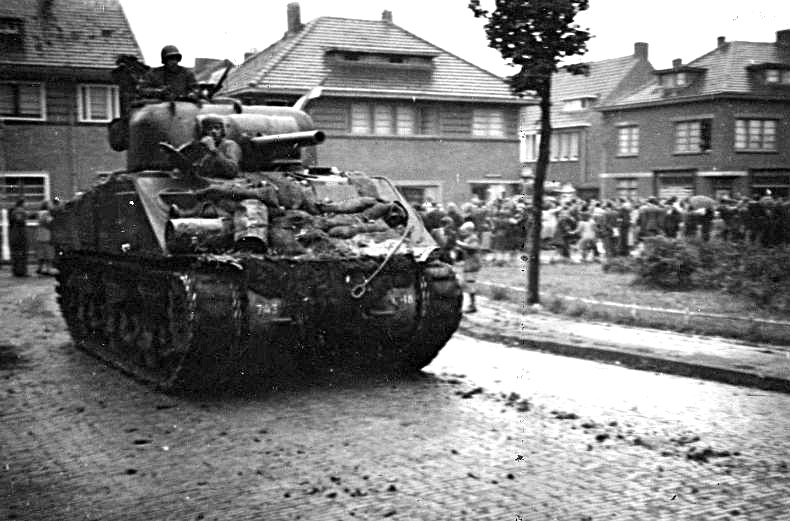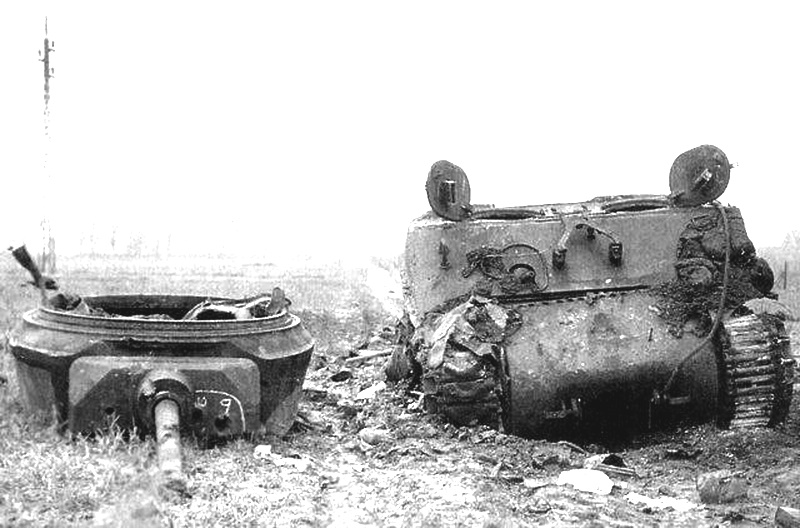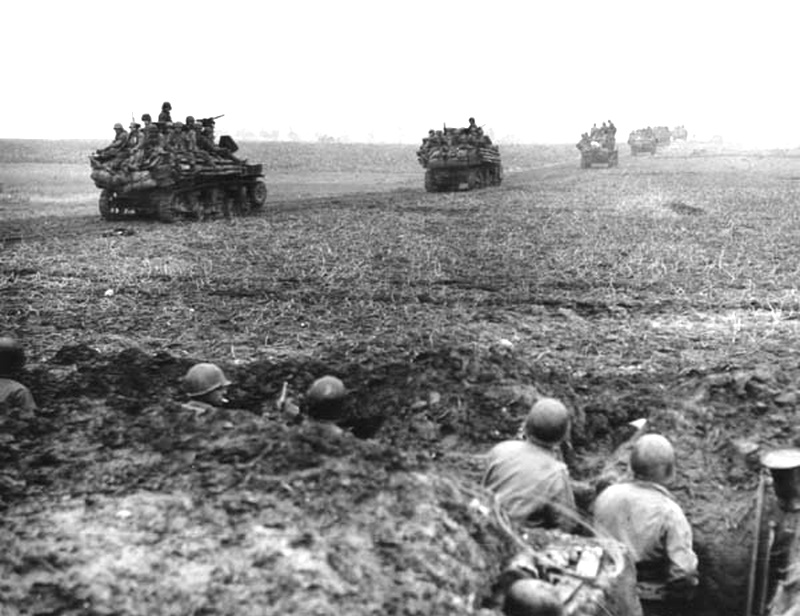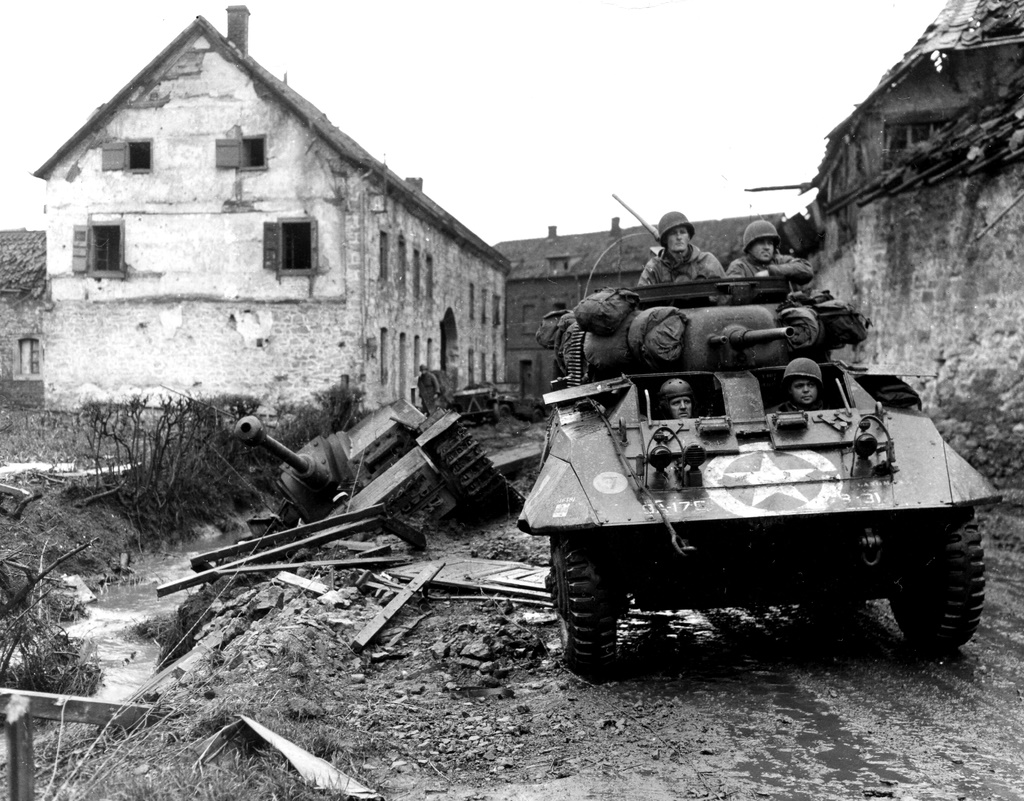Document Source: United States Army; Robinson, Wayne; and Hamilton, Norman E., Move out, verify: the combat story of the 743rd Tank Battalion, (1945). World War Regimental Histories. (http://digicom.bpl.lib.me.us/ww_reg_his/66) – (Bangor Public Library, 145 Harlow Street, Bangor, Maine, 04401, USA). The part extracted relates to the Battle of the Bulge, December 16, 1944, to February 25, 1945. (Corrections (if) Photographs, Additional Research by Doc Snafu.)
Author’s Foreword

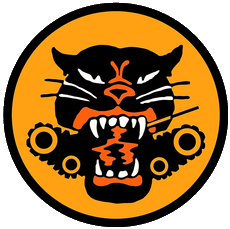 Sometimes, War can generate a complicated task to be done. A Battalion truck was driven hundreds of miles through Germany to locate and haul a linotype machine so that type could be set for this book. This is just one of the sometimes fantastic difficulties overcome during the manufacture of these pages in the bomb-devastated city of Frankfurt-on-Main (Germany) in July 1945. That the book did get printed at all is astonishing to its author. 1/Lt John D. Hess, aided by German-speaking T/Sgt Frank Gartner, looked after the considerable details of the publication. The 21-chapter illustrations are by Pfc Norman E. Hamilton. The writing is by Pfc Wayne Robinson, who here wishes to acknowledge the great help given by so many, from tank commanders to cooks to personnel clerks, in getting the facts for this combat story.
Sometimes, War can generate a complicated task to be done. A Battalion truck was driven hundreds of miles through Germany to locate and haul a linotype machine so that type could be set for this book. This is just one of the sometimes fantastic difficulties overcome during the manufacture of these pages in the bomb-devastated city of Frankfurt-on-Main (Germany) in July 1945. That the book did get printed at all is astonishing to its author. 1/Lt John D. Hess, aided by German-speaking T/Sgt Frank Gartner, looked after the considerable details of the publication. The 21-chapter illustrations are by Pfc Norman E. Hamilton. The writing is by Pfc Wayne Robinson, who here wishes to acknowledge the great help given by so many, from tank commanders to cooks to personnel clerks, in getting the facts for this combat story.
Kloster Kreuzberg (Germany)
July 10, 1945.
Tankers of the 743
 You have accomplished your mission in Europe. You have accomplished it only as great soldiers could. Never, from the day you hit the Normandy Invasion Beach until this day, have I had any doubts as to your courage or your willingness to sacrifice your lives for those of your comrades. ‘We Keep The Faith’. Yes, you have kept the faith of those who died in Flanders Field (Belgium) in ’17 and ’18, of those who died in the water and on the sands of Omaha Beach (France), of those who died beside, the hedgerows of Normandy, of those who fell in the orchards and farmlands of France, Belgium and Holland, of those who threw their soft bodies against the steel and cement obstacles of the Siegfried Line, of those who pushed to the Roer River, froze in the bitter winter campaign of the Ardennes (Belgium), and of those whose bodies were strewn from the Roer River to the Rhine River and from the Rhine River to the Elbe River. You have kept the faith your loved ones had in You, your country had in you, Col Upham had in you, and I had in you. Never has a man had the opportunity of working with and associating with a finer group of officers and men than you of the 743rd. You have met and defeated the best the Germans had. Now, many of you will meet and defeat the best the Japanese have. My prayers go with you.
You have accomplished your mission in Europe. You have accomplished it only as great soldiers could. Never, from the day you hit the Normandy Invasion Beach until this day, have I had any doubts as to your courage or your willingness to sacrifice your lives for those of your comrades. ‘We Keep The Faith’. Yes, you have kept the faith of those who died in Flanders Field (Belgium) in ’17 and ’18, of those who died in the water and on the sands of Omaha Beach (France), of those who died beside, the hedgerows of Normandy, of those who fell in the orchards and farmlands of France, Belgium and Holland, of those who threw their soft bodies against the steel and cement obstacles of the Siegfried Line, of those who pushed to the Roer River, froze in the bitter winter campaign of the Ardennes (Belgium), and of those whose bodies were strewn from the Roer River to the Rhine River and from the Rhine River to the Elbe River. You have kept the faith your loved ones had in You, your country had in you, Col Upham had in you, and I had in you. Never has a man had the opportunity of working with and associating with a finer group of officers and men than you of the 743rd. You have met and defeated the best the Germans had. Now, many of you will meet and defeat the best the Japanese have. My prayers go with you.
William D. Ducan
Lieutenant Colonel, Infantry
743rd Tank Battalion,
Commanding
November 8, 1944, the Drive to the Roer
The drive to the Roer River, seven miles east of Alsdorf (Germany), was set to start November 8, but sloppy weather delayed it until November 16. At 0100 in the morning, Col Duncan learned that the big attack would begin that day at 1245. Company commanders were summoned to the Alsdorf cellar command post. Able Company and the mortar platoon were attached to the 117th Infantry Regiment (30-ID), Baker Company and the assault gun platoon to the 120th Infantry Regiment (30-ID), and Charlie Company to the 119th Infantry Regiment. Dog Company was in reserve.
The hours before the H-hour jump-off were taken up with the final preparations for the long-anticipated drive. Tanks moved to assembly areas from which they would move out with the infantry. Heavy artillery and mortar fire rumbled away, blasting at known and suspected enemy positions. At 1145, fighter planes bearing the big white star on the blue circle charged in low over friendly lines and then circled over the sector like angry hornets looking for trouble. These planes were the pathfinders. They sought out the selected bomb strike area of Eschweiler (Germany), an assembly and distribution point for German troops. Smoke markers trailed their white streamers down through a hazy sky. At 1120, the air became heavy with the sound of bombers. Again to the veterans on the ground came that old throat-tightening sensation as men, thinking of St Lô (France), wondered if the air corps would find its mark as it was supposed to. The air strike went off according to plan, the bombs smashing up Eschweiler. Now until H-hour, the artillery kept working away, delivering its own brand of heavy punches. Another H-hour arrived, and the 30th Infantry Division troops moved forward.
Charlie 743 and the 119-IR hit the stiffest resistance. The other companies found the attack going ahead on schedule like clockwork. Able 743 had raced past slag piles into Mariadorf (Germany) and the 3rd Platoon of Baker 743 was on its objective at the outskirts of Euchen (Germany) within three hours after the jump-off. Charlie 743, on the right flank of the attack, was supposed to clear Wurselen (Germany) of the enemy. These were short days of fighting now compared to the long days in France. Dusk settled down shortly after 1700, and when dusk arrived on November 16, the infantry with Charlie 743 began digging in only 400 yards from their jump-off point.
 Charlie 743 lost two tanks and some good men that afternoon. 2/Lt Thomas J. Johnston, leading the 1st Platoon, was knocked out of his tank by Panzerschreck fire. He got one of his crew out, but the tank blew up before he could extricate the others. Later he was riding in another tank when this was hit, also by another Panzerschreck. The lieutenant got out safely, but when he took cover from the incoming mortar and artillery shells, he realized that his crew was not with him. He had no way of knowing that these men had taken safe shelter on the other side of the tank, out of his sight. The young platoon leader returned to the burning Sherman to rescue his crew members he thought were still inside. In this unselfish attempt, he was killed by machine gun fire. The attack continued the next day. While the lines were moving ahead, particularly on Able 743’s front at the left flank, this was no breakthrough. It was hard slugging. Charlie 743 was still finding the going rough at the far edge of Wurselen. Baker 743 took a sharp counterattack on the nose and moved hardly at all in streetfighting inside Euchen. Seven enemy tanks made their presence known with direct fire from a neighboring town of Linden (Germany). No Baker 743 tanks were lost in this fighting but Lt Winthrope Hastings, a platoon leader, was killed in the turret of his tank, struck by shell fragments.
Charlie 743 lost two tanks and some good men that afternoon. 2/Lt Thomas J. Johnston, leading the 1st Platoon, was knocked out of his tank by Panzerschreck fire. He got one of his crew out, but the tank blew up before he could extricate the others. Later he was riding in another tank when this was hit, also by another Panzerschreck. The lieutenant got out safely, but when he took cover from the incoming mortar and artillery shells, he realized that his crew was not with him. He had no way of knowing that these men had taken safe shelter on the other side of the tank, out of his sight. The young platoon leader returned to the burning Sherman to rescue his crew members he thought were still inside. In this unselfish attempt, he was killed by machine gun fire. The attack continued the next day. While the lines were moving ahead, particularly on Able 743’s front at the left flank, this was no breakthrough. It was hard slugging. Charlie 743 was still finding the going rough at the far edge of Wurselen. Baker 743 took a sharp counterattack on the nose and moved hardly at all in streetfighting inside Euchen. Seven enemy tanks made their presence known with direct fire from a neighboring town of Linden (Germany). No Baker 743 tanks were lost in this fighting but Lt Winthrope Hastings, a platoon leader, was killed in the turret of his tank, struck by shell fragments.
Charlie 743 did get into Wurselen on this second day. During the night, an estimated nine German companies had withdrawn in the darkness, but before Wurselen they had strewn many anti-tank and anti-personnel mines to add to the difficulties of the advance through observed artillery fire. Hongen (Germany) was a complete mess, the interiors of its houses strewn all over its narrow streets. In this setting, it amazed the eyes of some to see the debonair figure of a man in a frock coat and top hat strolling along, and, with deliberate care, he was flicking bits of the littered town out of his path with a cane. Bits of rooftop, bricks, plaster, wood, and rags were given the attention of this strange character who looked as if he might have stepped somehow from the pages of Dickens into the middle of a badly shelled town in the middle of a World War. The man in the top hat and frock coat was not out of Dickens hut out of a Baker 743, Capt Jean Uhbes.
As through all the previous fighting, the Battalion’s advance command posts were set up to work closely with the three infantry regiments. These three CPs were under the control of Lt Col Duncan, Maj Philips, and Capt Speers who kept in close contact with the tanks by radio. The CPs were often under heavy shell fire. The attack pressed on for the third day. The mortar and assault gun platoons were keeping up a heavy schedule of firing. The taking of the town of Warden (Germany) was a good example of how tanks infantry and artillery worked together to move the lines a few miles ahead in a day’s work. The day’s plan was for Able 743 to hold while the 3/117-IR took the bleak and unimpressive collection of homes, now brick piles, that was Warden. But the Germans were strongly entrenched in these brick piles and they threw the attacking doughs hack several times.
The commanders in the field drew up a new plan. To take Warden an artillery-infantry-tank attack was planned and offered to the Infantry Regimental Commander by Col Duncan. The plan was accepted. One infantry company (Charlie Co, 1st Infantry Battalion) was to drive in from the southwest of the town with three tanks led by Lt Joseph Couri. Another infantry company (Fox Co, 2nd Infantry Battalion) with Lt Joel Matteson leading this platoon from the town of Hongen. A third infantry group (Able Co, 1st Battalion) was to move in from Mariadorf (Germany) with Lt Jenkins and his three Shermans. The plan called for the doughs to ride the backs of the tanks with other doughs supporting on foot. Artillery was to put down a barrage of advance fire on Warden and all suspected gun positions. That was the plan. It was a neat, compact little plan but like all battle plans it was neat only as it would look on paper. Plans and maps leave out the human element the man. An unfought battle is the only one that seems clear and orderly as it is set down on a military map. Plans and maps have a way of leaving out the puddles in the ditches that a man slogs through the stone wall that saves his life as a mortar shell bursts near him, and most certainly it leaves out the fear and the hesitancies that snap through a man’s mind out in the field, and it does not take into account the foolish things he does and the brave things.
So the plan was set, a neat little battle. Then it was fought. Right at the beginning there was a slight hitch. There was trouble in getting everybody set to jump off at the same second. The attack was delayed at the last minute. But the information of this delay did not get through to Lt Matteson in Hongen. He moved out for Warden alone. Sgt Mason in a tank behind Matteson tried to inform his platoon leader of the time change but could not raise him on the radio. Rather than let Matteson proceed alone. Mason followed with his tank section, and two other Shermans commanded by Sgt William C. Beckett and Sgt Edwin D. Goodridt; both top-rate tank commanders. The four tanks raced for Warden. There were 16 doughs in the tanks. The artillery support was excellent, smashing up the opposition ahead of them. Within 30 minutes, the section was on the objective of the town itself. The infantry on foot moved up and then walked with veteran deliberateness into the town with the four tanks.
By this time, Lt Jenkins’ section with infantry had launched their attack and was well inside their section of Warden. Lt Couri’s section also smashed into the town from its flank. Warden was now penetrated from three sides. On their way in, Matteson’s platoon knocked out one AT gun firing from the flank and an enemy artillery observation post complete with observers, they overran two AT guns and put out of action two self-propelled guns mounting 75-MM weapons. Jenkins section knocked out at least four enemy machine gun positions. Couri’s tanks could account for three machine gun nests silenced by a railroad bank. All tanks had opportunities to shoot up enemy infantrymen and made the most of such opportunities. And so, by the end of the day, Warden was taken. Nobody in the tanks had gotten hurt, even though enemy direct-fire weapons had tried to shoot them at the last through buildings firing armored piercing shells into the houses in an attempt to blast holes in the structures to expose the tanks behind them to their fire. The infantry, as always, had it; casualties. In Warden, as night fell, positions were consolidated. The ambulances went back and the supply trucks came forward. The Germans had a new town to put under artillery fire. The artillery came in, salvo after salvo, the final emphatic touch to the taking of another German town.
Weeks of patient planning and re-planning of the attack now launched toward the Roer River. Weeks in which the closest coordination between artillery, infantry, tanks, and air was sought, were showing results not only here on the 30th Infantry Division front, but in the many active sectors now pressing back Germany’s border. In grim, dark November weather, its cheerless, overcast days marked the mood of the war, Allied pushes were slowly but steadily forcing a patchwork Wehrmacht hack through the defenses it was trying to stubbornly hold. The Germans made each town a battle point. Verify, with infantry riding its tanks, moved ahead. Able 743 chased the enemy out of a beaten-up coal town named Kinzweiler (Germany). Baker 743 lined up its Shermans and gave direct fire support to Charlie 743 which made a quick, all-out dash in a blitz attack on St ]oris (Germany) simultaneously with Able 743 on Kinzweiler. Enemy, mud, and mines hampered operations but did not stop them.
Some 400 yards outside Kinzweiler during the attack there the tanks ran into a minefield. All tanks were held up except Lt Jenkins, the first on the scene, who went right across the field followed by his platoon without striking a mine. Then the rest of the tanks tried it, with less luck. Three struck mines and another bogged down in deep mud. No one was hurt. The rains came and continued to come. But on November 21, the attack was taken up after a one-day respite. From a southerly direction, the attack suddenly shifted northeast and took the five towns of Lurken (Germany), Langweiler (Germany), Laurensberg (Germany), Ohermerz (Germany) and Langendorf (Germany). The enemy was caught by surprise. ‘The battleground off the roads is so muddy that there seems no bottom to it’, reported a tank commander about the operating conditions under which the drive pressed forward. And the rain continued to fall. The enemy, off-balance on November 21, stiffened his resistance a day later. The enemy’s direct fire was heavy. It came from AT guns, tanks, and self-propelled guns as Baker 743, Charlie 743, and Dog 743 worked together. And there was the rain. A constant, cold drizzle that fogged the tank periscopes.
‘A man just got wet and stayed wet’, a tanker said. ‘At least, we don’t have to walk through the stuff like the doughs’. Five tanks were lost in action on November 22, the day before Thanksgiving. Three of these were light tanks caught by direct fire in a muddy orchard outside the village of Erherich (Germany). One officer, Lt Frank X. McWilliams, and four enlisted men were killed by the enemy weapon, thought to have been a self-propelled 75-MM gun. An enemy AT gun stopped Lt Clyde S. Thornell’s new medium tank, killing his assistant driver. Ten minutes later Lt Clifford H. Disbrow was knocked out of his Sherman, also a new model, when it ran into some American AT mines. Both of these tanks, which were built with more armor than earlier Shermans, burned. later when they were enveloped by direct fire from enemy tanks that appeared from the south.
Thanksgiving Day was just another day of warfare for the Battalion – marked by the traditional turkey dinners whatever it was possible for the cooks to get the ‘holiday’ meal to the men. Charlie Co was busy until the next day, and Baker Co was two days late eating their share of the fixin’s. On Thanksgiving Day, one platoon of Baker Co with a platoon from Charlie Co supported the 120-IR’s attack to overcome the resistance at Lohn (Germany), at last taking the town in a one-hour battle. Able Co attacked Pattern (Germany), a town almost at the banks of the Roer River. The Able Co attack was climaxed by the adventure of Capt Korrison, Able’s commander, and three new giant specimens of Nazi armor, Panzerjager Panthers. These ‘tank hunters’ were steel brutes that mounted 88-MM guns. While elements of Baker Co put down supporting fire at one side of the town, Able Co’s column barrelled down the road into Pattern from another direction.
The tanks tore into the place wide open. Capt Korrison was in the lead. He could hardly believe his eyes when he spotted the sides of a twin pair of Panzerjager Panthers parked on a side road and apparently concerned with Baker Co’s diverting fire. The fast charge almost got by the two enemy tanks – but not quite. Capt Korrison pulled up short, and in rapid order put shells into the Panzerjagers, knocking both of them out at a range of between 50 and 75 yards. The flying column then proceeded into Pattern. A third Panzerjager was put out of action a little later in the fighting when it was spotted trying to hide behind a building. The Shermans took a position less than 100 yards away, then blasted a hole through the building. Through this hole, the Panzerjager was knocked out.












